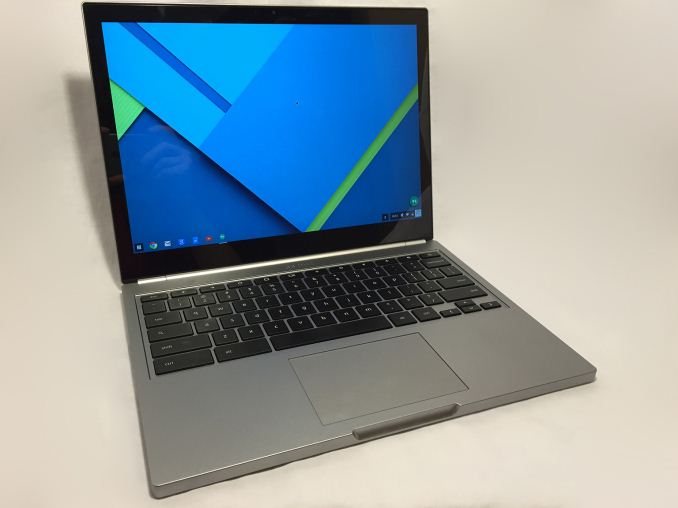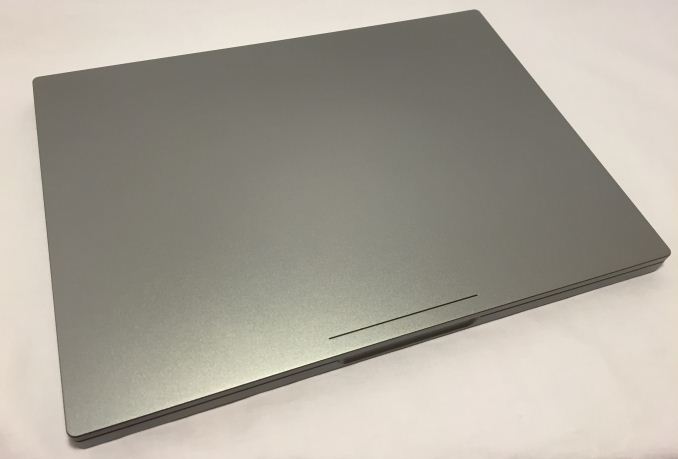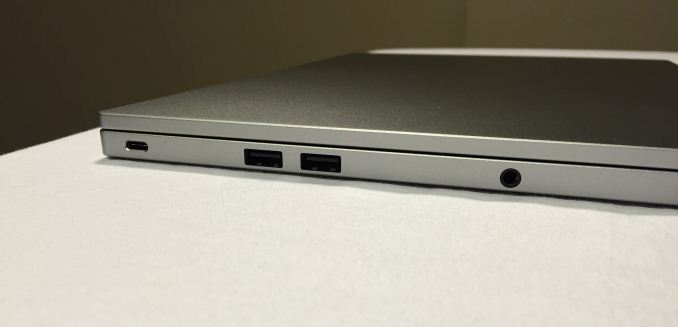The Chromebook Pixel (2015) Review
by Brandon Chester on March 16, 2015 8:00 AM EST- Posted in
- Laptops
- Chrome OS
- Chromebook
- Chromebook Pixel

Google's Chrome OS has always been similar to Microsoft Windows in how one company provides the operating system for many different manufacturers to use on their own devices. But two years ago, Google decided to create a Chromebook which was solely Google branded and designed. Although Chromebooks typically aim at the inexpensive part of the laptop market, this Google branded Chromebook had specifications that put it in line with high end Ultrabooks, and an equally high price tag. It was the original Chromebook Pixel, and its name referred to its 2560x1700 IPS display. At 239ppi it had the highest pixel density of any laptop in the world when it was released, and the rest of its specs were also impressive. In our original review of it, we concluded that it was an impressive laptop, but that its starting price of $1299 was quite a barrier to entry. In addition Chrome OS was more limited at that time than it is today.
That brings us to the new Chromebook Pixel which was released just last week. At first glance, you would be hard pressed to tell the difference between this new model and the old one. It has a similar high resolution display, and the same aluminum body with flat edges. But a look at the sides of the chassis will reveal a pair of highly versatile USB Type-C ports, and a figurative look inside will show one of Intel's new Broadwell CPUs which enables high performance and stellar battery life. Before we dive into the new Chromebook Pixel, I've compared it with the original Pixel from 2013 in the chart below.
| Chromebook Pixel (2013) | Chromebook Pixel (2015) | Chromebook Pixel LS | |
| Dimensions | 11.72 x 8.84 x 0.64" (297.7 x 224.5 x 16.3mm) | ||
| Mass | 3.35 lbs (1.52kg) | ||
| CPU | Core i5-3337U (2 cores + HT) | Core i5-5200U (2 cores + HT) | Core i7-5500U (2 cores + HT) |
| L3 Cache | 3MB | 3MB | 4MB |
| Base CPU Clock | 1.8GHz | 2.2GHz | 2.4GHz |
| Max CPU Turbo | 2.7GHz | 2.7GHz | 3.0GHz |
| GPU | Intel HD 4000 | Intel HD 5500 | Intel HD 5500 |
| System Memory | 4GB DDR3L-1600 | 8GB LPDDR3-1600 | 16GB LPDDR3-1600 |
| Storage | 32GB SSD | 32GB SSD | 64GB SSD |
| Display | 12.85" 2560x1700 IPS LCD | ||
| Battery | 59 Wh | ||
| Ports | 2 x USB 2.0, Mini DisplayPort, 3.5mm audio | 2 x USB Type-C, 2 x USB 3.0, 3.5mm audio, SD card | |
| Connectivity | 2x2 802.11a/b/g/n + BT 3.0 | 2x2 802.11a/b/g/n/ac + BT 4.0 | |
| Launch Price | $1299 | $999 | $1299 |
Some investigation into the Pixel's hardware reveals a few more details about it. The version sent by Google was the normal Intel i5 model, and although I don't expect the suppliers would be different for parts of the "Ludicrous Speed" model, it's still possible. In addition, parts like the RAM and SSD could be sourced from multiple vendors, although this is again unlikely due to the relatively small number of units that will be manufactured.
The original Pixel used a Sandisk iSSD, while this new Pixel uses an SSD made by Kingston. It's likely that it's still soldered to the motherboard which makes replacing or upgrading it impossible. Given that the Pixel can only be disassembled using suction cups and a great deal of force I'm not able to actually look inside to check. In addition, the i5 model of the Pixel uses two 4GB LPDDR3 modules which are manufactured by Samsung.
The chassis of the new Pixel is just as impressive as the previous model. The aluminum construction feels incredibly solid, and is heavy but not excessively so. When you first look at it, you'll notice that the device itself is slightly more square than other laptops, as a result of its 3:2 display. This square profile also extends to the sides and edges of the Pixel, which are as flat as can be. The top of the device also retains the LED light bar from the original model, which lights up in green, yellow, red, and blue colors and has a very Googley feel to it. Tapping twice on the top of the laptop will cause some of the LEDs on the light bar to turn on, and the color and number of LEDs gives you an approximation of how much battery life you have left. All these little details result in a really unique design, and its been clear since the original Pixel that Google wanted to create their own device instead of just carbon copying another laptop
Upon opening the Pixel, you'll be greeted by a uniquely shaped LCD display surrounded by a fairly thin bezel. Beneath it are the keyboard and touchpad, both of which felt great to use. The keyboard had a comfortable amount of key travel, very little movement back and forth, and large well spaced key caps that made typing a breeze. The keyboard also acts as the vent for the Pixel's fans, and the speakers are hidden underneath. Google uses sensors to detect when your hands are over the keys, and so the keyboard backlight is only on when you're typing. The touchpad is covered by a smooth piece of glass, and it was responsive and accurate in use, which is something that can't be said about many other laptops regardless of price. One small complaint I have is that Chrome OS doesn't seem to support pinch to zoom on the touchpad. If it does, I certainly couldn't find the option anywhere I looked.
That brings us back to the display, which is a 3:2 touch enabled IPS LCD. Chrome OS seemed reasonably responsive using the touchscreen, although much like on Android multi-touch gestures like pinch to zoom didn't track well to how your fingers were actually moving inward and outward. I don't think that the touchscreen is really a necessary input method on a laptop, and in my experience it's not comfortable in the slightest to hold your arm up and poke at your laptop display, but the option is there for users who desire it. Google has also improved the display hinge to reduce the bounce back of the display when touching it.
The sides of the pixel have all of the ports for expansion. Google clearly believes that users enjoy having ports on their laptops, and so each side of the Pixel has a USB 3.0 Type-C port, along with two USB 3.0 Type-A ports and an audio jack on the left side, and an SD card slot on the right side. Google provides several adapters that can be used to transform the Type-C ports to other existing interfaces, including HDMI, DisplayPort, and both female and male USB Type-A.
The build quality of the Chromebook Pixel certainly inspires a great deal of confidence in the rest of the machine, so lets continue our examination of the new Pixel with a look at the improvements Google has made to the display.













123 Comments
View All Comments
some_guy - Saturday, April 11, 2015 - link
There are built in shortcuts for these keys along with a bunch of other shortcuts. ( Page up is Alt up arrow )https://support.google.com/chromebook/answer/18310...
My question is that if I were to install Linux, will the shortcuts also be there or will I have to do them myself somehow or search for something on the Internet. Thanks.
djscrew - Monday, March 16, 2015 - link
How come nearly every Chrome laptop is hideous.zodiacfml - Monday, March 16, 2015 - link
Too expensive. How much is the Yoga 3?cjb110 - Tuesday, March 17, 2015 - link
Is that battery charge test right? Seems a massive increase with no apparent reason that covers it, the components could only do so much. Kudos to Google if it is true, butl_d_allan - Tuesday, March 17, 2015 - link
Did I miss comments and evaluation about on-board storage? The SSD looks rather wimpy, but I didn't notice any numbers, charts, wordage one way or the other.Or is that considered irrelevant to a ChromeBook?
eanazag - Tuesday, March 17, 2015 - link
This is a laptop for Google employees.shm224 - Wednesday, March 18, 2015 - link
I still don't get why "browser/js engine" benchmarks are showing here as "CPU performance." I think Ho has once explained that that is purely for comparing the performance within the same product line, but I don't see any previous iterations (of Chromebooks) listed here. To the contrary, the web/js benchmarks are compared against the latest competing products as if they are at all relevant to CPU performance. I think the web/js benchmarks somewhat relevant here because everything on Chromebooks runs on Google's Chrome browser, but Anandtech still continues to use the same methodology to evaluate smartphones for instance where web browsing no longer represents much of smartphone usage.ntd11 - Friday, March 20, 2015 - link
How many here have tried a Chromebook for more than a few hours? I'm talking about logging in remotely and doing work from the comfort of a couch. Maybe its because I've been doing that sort of work since... 1992, back when the only computers that could do real work were called 'supercomputers' built up some habits. (Anyone else remember 'Xwindows?').After two years using a Chromebook I wanted something much better. For a year I haven't picked up my tablet. I either used my large smartphone, the Chromebook, or I wanted a multi-monitor workstation with the ergo keyboard/mouse, and enough RAM to actually do simulations.
I'm not the developer. But I look at it this way, everyone I've loaned my now obsolete Chromebook has bought one. Look at the benchmarks. If you log into a web page to work remotely, this is the machine. I used to have 20+ tabs open on a really low end Chromebook that would make a decent windows machine beg for mercy.
Take a minute to realize why the growing Chromebook community is excited about this laptop. I bet I'm the only one here actually posting from a Chromebook pixel. I came to read the review from a 'non-Chromebook fan site.'
Is it a great value? Well, so-so. But I wanted the long battery life. I like to wander to the back yard and work for hours. Then I wander into a quiet room and watch a movie. So nice to not worry about a power cord. The only downside is I find printing from a Chromebook not worth the hassle. I send documents to my windows machine and print from there. But look at the benchmarks. As a web browsing machine... this is fast.
Note: I do remote engineering. Not development for iPhones, Android, or Chromebooks. I use high end software that someone else has developed to simulate complex physics. This is now the Chromebook everyone can say 'that is too expensive' and buy one half (or less) the price. But
I find windows machines slow too much with age. My old Chromebook never did. Apple machines slow with every OS upgrade. It is preference.
HanTorso - Thursday, April 9, 2015 - link
I feel this would be great if it just had at least a 256gb ssd. I would install Linux on it, and maybe use the Chrome OS just for simple things. The most important element is the 3:2 aspect ratio, which makes it superior to any non-Apple laptop display. The price is still too expensive though, because except for the screen, it doesn''t seem to have any advantage over an Apple laptop of the same price.dodysw - Sunday, May 31, 2015 - link
Brandon, according to https://support.google.com/chromebook/answer/61645... the Chromebook Pixel 2015 battery capacity is 72Wh, not 59Wh as specified in your article.